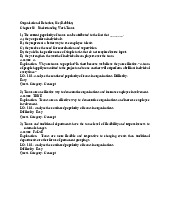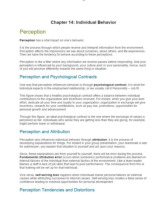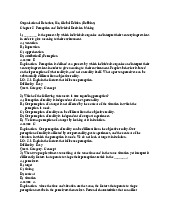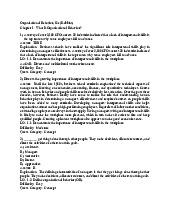







Preview text:
Question 1: In the early 20th century, how did managers generally perceive the impact of work specialization?
A. a means to encourage employee satisfaction
B. a frustrating cause of reduced product output
C. an unending source of increased productivity
D. difficult to implement without automation technology
E. an effective solution to over-centralization
Question 2: Imagine you're negotiating a price for a used car. The seller starts with a high number. What
bias might they be trying to trigger in you? A. self-serving B. framing C. attributional D. anchoring E. Belief
Question 3: Imagine two colleagues debating the most efficient way to divide responsibilities or handle
tasks. What type of conflict are they experiencing? A. communication B. task C. job D. relationship E. process
Question 4: Charismatic leaders ________.
A. engage in traditional behaviors that follow norms
B. focus on their own responsibilities largely ignoring the needs and feelings of employees C. avoid personal risk
D. propose a vision of the future that is better than the status quo
E. ensure their own position as leader even if it means sacrificing others
Question 5: What do you call it when everyone gets a little bit of what they want, instead of a whole
plate of disappointment? A. collaborating B. compromising C. avoiding D. competing E. Accommodating
Question 6: Which of the following best aligns with current trends in businesses aiming to cut costs,
streamline operations, boost decisions, adapt quickly, connect with customers, and empower workers? A. wider span of control
B. high degree of formalization C. longer chain of command
D. lack of work specialization
E. high degree of centralization
Question 7: When colleagues disagree about what the project goals or work content should be, what
kind of conflict arises? A. job B. task C. relationship D. process E. Communication
Question 8: In a highly formalized job, what's the least likely to be part of it?
A. clearly defined procedures on work processes B. explicit job description
C. high employee job discretion
D. a large number of organizational rulesE. a consistent and uniform output
Question 9: Think of a chain, with each link representing a level of authority in an organization. In this
example, the chain leads directly from the CEO to every employee, with no room for independent
decision-making at lower levels. This type of organization, with a strict hierarchy and limited autonomy,
is most likely characterized by ______ A. a narrower span of control
B. a low degree of formalization
C. a high degree of centralization
D. a high degree of departmentalization
E. a low degree of work specialization
Question 10: How are different job roles categorized and structured within an organization? A. social clustering B. span of control C. work specialization D. centralization E. departmentalization
Question 11: Leaders who function primarily by clarifying role and task requirements to accomplish
established goals exhibit a(n) ________ style of leadership. A. transformational B. transactional C. charismatic D. laissez-faire E. employee-oriented
Question 12: ________ leaders inspire followers to transcend their self-interests for the good of the
organization and can have an extraordinary effect on their followers. A. Transformational B. Transactional C. Task-oriented D. Laissez-faire E. Production-oriented
Question 13: Which of the following Big Five personality traits has been identified as the most important
trait in effective leaders? A. conscientiousness B. openness C. extraversion D. agreeableness E. emotional stability
Question 14: Transformational leaders enhance performance of employees by ________.
A. restricting creativity among employees
B. focusing on short-term goals for employees
C. instilling pride in employees
D. establishing goals, roles, and requirements
E. abdicating all responsibility to employees
Question 15: In the context of behavioral dimensions of leadership identified in the Ohio State Studies,
________ is the extent to which a person's job relationships are characterized by mutual trust, respect
for employees' ideas, and regard for their feelings. A. consideration B. transaction C. authentication
D. task orientationE. Identification
Question 16: The Ohio State Studies narrowed the independent dimensions of leader behavior to two
that substantially accounted for most of the leadership behavior described by employees:
consideration and ________. A. employee-orientation B. empathy C. constructing vision D. initiating structure E. charisma
Question 17: Leadership is best defined as ________.
A. the ability to merely project one's abilities in the lack of actual accomplishments
B. the ability to reduce the dependence of team members on each other
C. the ability to induce the team members to focus on individual goals rather than collective goals
D. the ability to influence a group toward the achievement of a vision or set of goals
E. the ability to use factors like training and experience to reduce dependence on formal leadership
Question 18: According to evidence, what is the first step a charismatic leader takes to influence followers?
A. by developing an aura of charisma
B. engaging in emotion-inducing and often unconventional behavior
C. setting an example for followers through actions and words
D. articulating an appealing vision
E. communicating high performance expectations
Question 19: In terms of the full range of leadership models, which leadership behavior represents the
most active and effective approach for leaders? A. contingent reward B. idealized influence
C. management by exception (active)
D. individualized considerationE. laissez-faire
Question 20: Emotional intelligence (EI) is critical to effective leadership because one of its core
components is ________, which reflects the consideration that leaders must be able to express. A. conscientiousness B. empathy C. optimism D. introversion E. perfectionism
Question 21: Work groups are characterized by ________.
A. the emphasis on generating positive synergy
B. the goal of sharing information among members
C. the mutual and team-based accountability for results
D. the need to attain collective performance
E. the availability of complementary skill sets
Question 22: A team that has a good plan but is also willing to adjust its master plan and adapt when
conditions call for it demonstrates high ________, an important variable in successful team processes. A. goal specificity B. goal congruency C. conformity D. diversity E. reflexivity
Question 23: ________ illustrates a process loss from using teams. A. Organizational demography B. Role conflict C. Social loafing D. Multitasking E. Profit-sharing
Question 24: Gerald Murphy is a manager at Wright & Wayner, a publishing house which is a very
employee-friendly company. The demarcation between managers and subordinates is flexible and the
nature of these reporting relationships is flexible and informal. Gerald recently assigned five of eight of
his subordinates to work on a new publication project with a fairly tight deadline because he believed
that these efficient employees would function even better with each other's support. A week before the
deadline, however, Gerald realized that the group had been shirking work as each of the members
thought that the project was not just his or her responsibility. Additionally, under the guise of working
together, the team was actually doing their personal work, surfing the Internet, or just socializing. This
scenario reflects ________. A. gainsharing B. high process gains C. reflexive goal-setting D. job sharing E. social loafing
Question 25: Which of the following accurately differentiates between work groups and work teams? A.
Work groups are used by top-management employees, while work teams are used by lower- levelworkers. B.
Work groups are used for functions relating to areas of the external environment, while work teams
areexclusively used for departmental problems and issues. C.
Work groups involve members who have complementary skills, while work teams use employees
whohave random and varied skills.
D. Work teams generate a potential for an organization to generate greater outputs with no increase in
inputs, while work groups cannot perform this function.
E. Work teams represent the mere accumulation of individual efforts, while work groups generate a positive
synergy within the organization.
Question 26: Which of the following statements is true regarding self-managed work teams? A.
Self-managed work teams typically consist of forty to fifty employees.
B. Self-managed work teams typically manage conflicts well.
C. Members of self-managed work teams typically report lower job satisfaction.
D. Self-managed work teams are typically composed of employees from different departments who
workindependent of each other.
E. In the case of self-managed work teams, supervisory positions take on decreased importance.
Question 27: Which of the following statements is true regarding a work team? A.
Work teams are rarely used in organizations today.
B. Work teams are generally less flexible than traditional departments.
C. Work teams generate positive synergy through coordinated effort.
D. Work teams are less responsive to changes in the internal and external environment of the company.
E. Work teams involve members of random and varied skill sets.
Question 28: Which of the following statements is true regarding the size of teams? A.
The most effective teams have twelve to fifteen members.
B. When teams have excess members, cohesiveness declines.
C. As team size increases, social loafing decreases.
D. When teams have excess members, mutual accountability increases.
E. Members of large teams coordinate work better when pressed for time.
Question 29: Which of the following is not one of the key components of effective teams? A. climate of trust B. c ompany reputation C. adequate resources D. member flexibility E. leadership and structure
Question 30: To retain its edge in the organic health food market, Natura has established a highpriority
team comprised of senior executives from the company's production, marketing, and research divisions.
These employees work together closely to study consumer attitudes about organic health foods and come
up with a closely monitored development and marketing strategy for new products. This ensures that
each division is informed of the specific needs, timelines, and expected outcomes of the strategy. It also
makes Natura a company that adapts to changes in market trends swiftly. The team Natura uses here is of the ________ type. A. problem-solving B. self-managed work C. cross-functional D. traditional E. Departmental
Question 31: In the last one week, May and Phyllis have been putting in extra hours at work so that the
project assigned to them is completed on time. Though the manager was due to assign two more people
to this project, he had not done so and, instead, was emphasizing to employees the importance of
adhering to the needs of the department in regard to workload. As a result, May and Phyllis, who had
double their routine workload, complained to the division manager. May was promptly suspended from
work for complaining about her immediate supervisor. This scenario describes ________ power. A. reward B. legitimate C. coercive D. expert E. Referent
Question 32: Which of the following types of power is most likely to be negatively related to employee
satisfaction and commitment? A. expert power B. reward power C. legitimate power D. coercive power E. referent power
Question 33: For a person to be recognized as having a high degree of political skill, he or she must have the ________.
A. ability to recognize that power in an organization does not translate into success
B. ability to submit to the demands made by others at all times
C. ability to influence others to enhance their own objectives
D. ability to respect and consider the needs of others first
E. ability to make sacrifices for the betterment of others
Question 34: Which of the following is an assertive impression management technique? A. conformity B. apologies C. self-promotion D. flattery E. buffing
Question 35: Levin and Co. is a group of oil refineries that has been in the news recently. The company
had to stop production for over two weeks because their key supplier refused to sell them crude oil at
the old prices. Even after rounds of negotiations, the supplier refused to give in to the demands of Levin
and Co., and finally, the company had to acquire the raw material from the same supplier because
alternative suppliers, though abundant, could not provide the quantities the company demanded at such
short notice. This shows the role of ________ in increasing the power one enjoys. A. alternatives B. dependence C. abundance D. substitutability E. Exchange
Question 36: Which of the following is true with regard to bases of power?
A. Coercive power involves an identification with and imitation of the person in power.
B. Legitimate power is used by companies when they hire celebrities to promote their products.
C. Expert and referent power are the two major types of formal power.
D. The personal sources of power are most effective for increasing employee performance and satisfaction.
E. Reward power is the most common and broad type of power seen in operation in organizations.
Question 37: Which of the following statements is true regarding legitimate power?
A. Legitimate power develops out of admiration of another and a desire to be like that person.
B. Legitimate power comes from an individual's unique characteristics.
C. Legitimate power is broader than the power to coerce and reward.
D. Celebrities who endorse products in commercials wield legitimate power over people.
E. Legitimate power is a type of personal power.
Question 38: Which of the following is something that often differentiates power from leadership?
A. lack of dependence of followers
B. use of positive styles over negative tactics
C. downward influence of leader on followers
D. lack of goal compatibility between leaders and followers
E. lack of control on behavior of followers
Question 39: ________ is the only tactic effective across organizational levels. A. Legitimacy B. Inspirational appeal C. Rational persuasion D. IngratiationE. Pressure
Question 40: Carl believes that he is lucky to be working under a manager like Mr. Parker–
conscientious, flexible and easy to work with. It was Mr. Parker who helped Carl learn the demands of
the job, gave him opportunities to learn from the mistakes he made, and always provided sound advice.
Mr. Parker, who has been in the field for over eighteen years, never made Carl feel like a novice and
this only increased Carl's personal confidence in his work and his loyalty toward his manager. Carl,
who is now doing very well on the job, aims to be a manager like Mr. Parker. From this scenario, which
of the following conclusions can be drawn? A. Mr. Parker is an authoritarian manager.
B. Carl has a low degree of trust propensity.
C. Mr. Parker has a high degree of referent power.
D. Mr. Parker engages in a lot of ingratiation.
E. Mr. Parker exercises a high degree of coercive power.
Question 41: ________ refers to the adjustment of one's behavior to align with the norms of the group. A. Deviance B. Conflict C. Divergence D. Conformity E. Appearance
Question 42: The controller role in a team is responsible for ________. A. initiating creative ideas
B. examining details and enforcing rules
C. offering insightful analysis of options
D. coordinating and integrating group tasks
E. providing directions and following up with implementation
Question 43: Which of the following is true with regard to the social identity theory?
A. It proposes that members take personal pride in accomplishments but dissociate from the group in the
event of any offenses or failures.
B. It proposes that people have emotional reactions to the failure or success of their group because their self-
esteem is tied into the group's performance. C.
It proposes that people develop only one social identity in childhood that becomes more defined
andconcrete in the course of their lives. D.
It proposes that social identities can never be detrimental as they have no effect on how members of
aningroup view members of an out-group. E.
It proposes that members of an ingroup are viewed as being homogeneous, while members of an
out-group are seen as being heterogeneous.
Question 44: Status refers to the ________.
A. impact that support of group norms has on workplace civility
B. adjustment of one's behavior to align with the norms of the group
C. socially defined position or rank given to groups or group members by others
D. existence of roles that are at variance with one another
E. acceptable standards of behavior within a group that are shared by the group's members
Question 45: The adviser role in a team is responsible for ________. A. providing structure B. fighting external battles
C. offering insightful analysis of options
D. coordinating and integrating group tasks
E. encouraging the search for more information
Question 46: Role ________ is defined as the way others believe you should act in a given context. A. fuzziness B. expectation C. conflict D. perception E. Enhancement
Question 47: When ________, the result is role conflict.
A. compliance with one role aids our performance in another role
B. compliance with the group is an attempt to understand who we are and how we fit into the world
C. compliance with the group is marked by a tendency to notice and emphasize those aspects of the groupthat are distinctive
D. compliance with one role requirement may make it difficult to comply with another
E. compliance with the group is strengthened by members who have similar values and characteristics
Question 48: Which of the following represents the second action in the group development process of a temporary group? A. group direction set
B. transition after half of time taken up C. inertia and slow progress
D. second phase of inertiaE. accelerated activity
Question 49: A group decision-making method in which individual members meet face-to-face to pool
their judgments in a systematic but independent fashion is the ________ technique. A. reference groups B. nominal groups C. brainstorming
D. interacting groupsE. Ingroup
Question 50: Which of the following represents the major determinants of group development and
functioning as depicted by the punctuated-equilibrium model?
A. better perspectives and patterns
B. group solidarity and collectivist goals C. promotion of diversity
D. deadlines and time constraints
E. role perception and expectation




